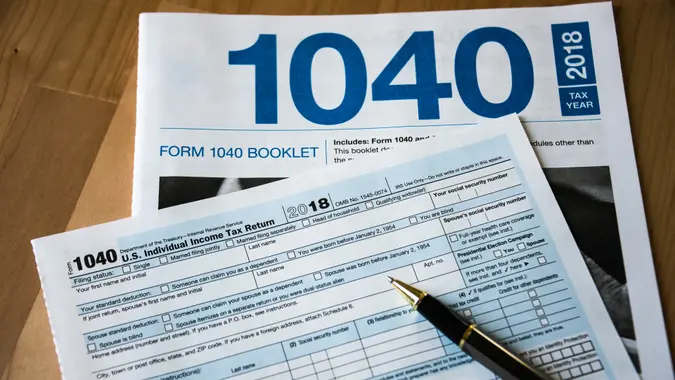What Are Progressive Taxes and How Do They Work?

Commitment to Our Readers
GOBankingRates' editorial team is committed to bringing you unbiased reviews and information. We use data-driven methodologies to evaluate financial products and services - our reviews and ratings are not influenced by advertisers. You can read more about our editorial guidelines and our products and services review methodology.

20 Years
Helping You Live Richer

Reviewed
by Experts

Trusted by
Millions of Readers
A progressive tax is a system where the tax rate increases as taxable income rises, requiring higher earners to pay a greater percentage of their earnings than those with lower incomes. The tax rate, levied as a percentage of taxable income according to defined brackets, differs from the tax amount, which is a fixed sum calculated using the effective tax rate.
How a Progressive Tax System Works
Progressive tax systems do not tax all income levels at the same rate. Instead, they levy taxes according to a graduated series of brackets that scale up as income rises, which requires most earners to pay different rates on different portions of their income.
For example, someone with $80,000 in taxable income — the portion of gross income subject to taxation after deductions — falls into the 22% tax bracket. However, that person won’t pay 22% on the whole $80,000 because of the way brackets are structured in the U.S.’s progressive tax system.
Examples of Progressive Taxes in the U.S.
The familiar IRS brackets from the federal tax system are an example of a progressive tax. The more you earn, the higher rate you pay — but only on the portion of your income that falls into a given bracket.
Here are the 2025 federal tax brackets.
| Tax Rate | Income Level |
|---|---|
| 10% | Incomes of $11,925 or less ($23,850 or less for couples filing jointly) |
| 12% | Incomes over $11,925 ($23,850 for couples filing jointly) |
| 22% | Incomes over $48,475 ($96,950 for couples filing jointly). |
| 24% | Incomes over $103,350 ($206,700 for couples filing jointly) |
| 32% | Incomes over $197,300 ($394,600 for couples filing jointly). |
| 35% | Incomes over $250,525 ($501,050 for couples filing jointly) |
| 37% | Incomes over $626,350 ($751,600 for couples filing jointly |
For the taxpayer from the previous example with $80,000 in taxable income:
- The first $11,925 would be taxed at a rate of 10%.
- The portion between $11,926 and $48,475 would be taxed at a rate of 12%.
- Only the remaining $31,524 — the portion between $48,476 and $80,000 — would be taxed at a rate of 22%.
Progressive vs. Flat and Regressive Taxes
Progressive taxes, which require higher earners to pay a larger percentage of their income, are just one system. Others are income-neutral, which can end up over-taxing lower earners while allowing wealthier individuals to pay less.
- Flat tax: Charges the same percentage for everyone, regardless of income.
- Regressive tax: Flat taxes can actually be regressive taxes, taking a larger percentage from low-income earners than from wealthier taxpayers. For example, most states raise revenue through flat-rate sales taxes. In Utah, where the average sales tax is 7.32%, buying a $30,000 car would generate a $2,196 sales tax bill. For someone earning $50,000 a year, that’s 4.4% of their income. But for someone who makes $500,000, it’s just 0.44%.
Pros and Cons of Progressive Taxation
Advocates of progressive taxation argue that the system fosters equity, reduces economic inequality and generates higher revenue from wealthier people who are better positioned to absorb the hit.
However, detractors believe it disincentivizes maximum production from high earners, who invariably find refuge in the numerous available loopholes, and complicates tax collection and revenue generation.
Is the U.S. Tax System Progressive?
Generally speaking, the U.S. collects revenue through a progressive tax system, but there are several important caveats.
- Tax deductions can favor the wealthy, who can use them to drop down to lower brackets, dramatically reducing their tax burden, while lower earners have less to deduct and less room to maneuver downward.
- The effective tax rate can vary when savvy taxpayers use strategies like harvesting losses, deferring bonuses and accelerating deductions.
- State taxes, like general sales tax and excise taxes on things like gas, are flat-rate taxes that take a larger percentage of lower earners’ income.
- Tax rates for long-term capital gains, which many wealthy households rely on for the bulk of their income, are lower than rates for ordinary income.
- Where you live matters — 14 states have flat-rate income tax structures, 27 states and Washington, D.C., use graduated-rate structures and nine states don’t levy a state income tax.
Why Understanding Progressive Taxes Matters
Understanding taxes is essential because satisfying your obligation requires budgeting and strategic financial planning. Progressive systems, like the IRS uses for federal taxes, can promote broader economic fairness, but they are inherently more complex than flat-rate structures.
Learning about its intricacies, including the portions of your income that are taxed in different brackets and how deductions can lower your taxable income, is the key to reducing your burden and keeping as much of your hard-earned money as possible.
FAQ
Here are the answers to some of the most frequently asked questions about progressive taxes.- What is an example of a progressive tax?
- The U.S. federal government uses a progressive system to collect revenue, including graduated tax brackets where the tax rate increases as income rises.
- What is the difference between a progressive and regressive tax?
- Progressive systems require higher earners to pay a larger percentage of their income than lower earners. Regressive taxes take a greater income percentage from lower earners.
- Are sales taxes progressive?
- No. Sales taxes are flat-rate taxes that are effectively regressive taxes.
- Do higher earners pay a higher percentage in the U.S.?
- Yes. Higher earners fall into higher tax brackets and pay a greater percentage of their income. However, loopholes like the long-term capital gains rate allow many high earners to pay less than the system was designed to collect.
- Is the progressive tax system fair?
- “Fair” is a subjective term, but it is designed to promote financial equity and reduce economic disparity.
Karen Doyle contributed to the reporting of this article.
Our in-house research team and on-site financial experts work together to create content that’s accurate, impartial, and up to date. We fact-check every single statistic, quote and fact using trusted primary resources to make sure the information we provide is correct. You can learn more about GOBankingRates’ processes and standards in our editorial policy.
- IRS. "IRS releases tax inflation adjustments for tax year 2025"
- Massachusetts Department of Revenue. "Personal Income Tax for Residents"
- Tax Foundation. "Analysis of Harris’s Billionaire Minimum Tax on Unrealized Capital Gains"
 Written by
Written by  Edited by
Edited by 

























